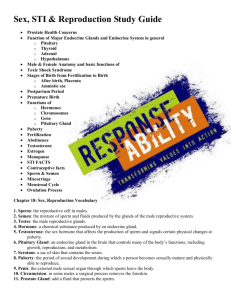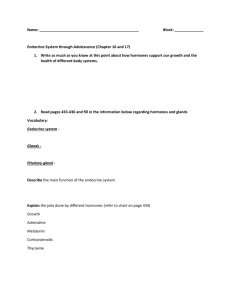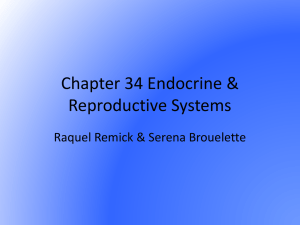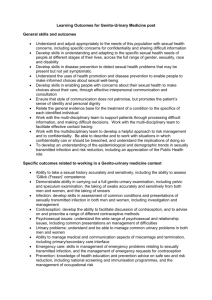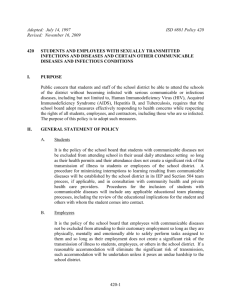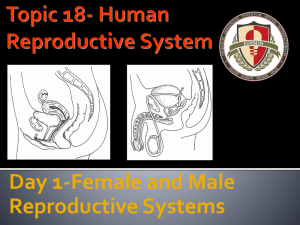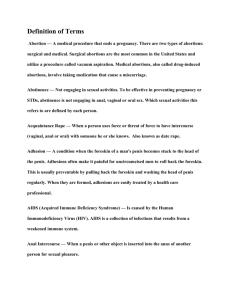Unit 7 SEX ED Study Guide Document
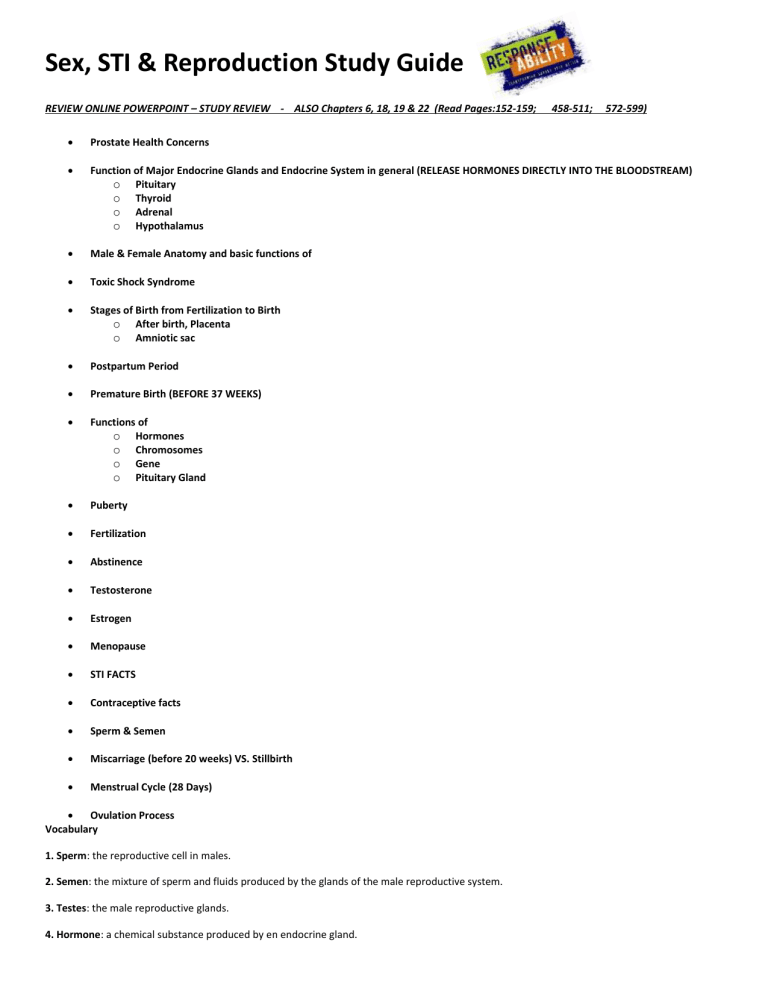
Sex, STI & Reproduction Study Guide
REVIEW ONLINE POWERPOINT – STUDY REVIEW - ALSO Chapters 6, 18, 19 & 22 (Read Pages:152-159; 458-511; 572-599)
Prostate Health Concerns
Function of Major Endocrine Glands and Endocrine System in general (RELEASE HORMONES DIRECTLY INTO THE BLOODSTREAM) o Pituitary o Thyroid o Adrenal o Hypothalamus
Male & Female Anatomy and basic functions of
Toxic Shock Syndrome
Stages of Birth from Fertilization to Birth o
After birth, Placenta o Amniotic sac
Postpartum Period
Premature Birth (BEFORE 37 WEEKS)
Functions of o Hormones o Chromosomes o Gene o Pituitary Gland
Puberty
Fertilization
Abstinence
Testosterone
Estrogen
Menopause
STI FACTS
Contraceptive facts
Sperm & Semen
Miscarriage (before 20 weeks) VS. Stillbirth
Menstrual Cycle (28 Days)
Ovulation Process
Vocabulary
1. Sperm: the reproductive cell in males.
2. Semen: the mixture of sperm and fluids produced by the glands of the male reproductive system.
3. Testes: the male reproductive glands.
4. Hormone: a chemical substance produced by en endocrine gland.
5. Testosterone: the sex hormone that affects the production of sperm and signals certain physical changes at puberty.
6. Pituitary Gland: an endocrine gland in the brain that controls many functions, including growth, reproduction, and metabolism.
7. Scrotum: a sac of skin that contains the testes.
8. Puberty: the period of sexual development during which a person becomes sexually mature and physically able to reproduce.
9. Penis: the external male sexual organ through which sperm leave the body.
10. Circumcision: in some males a surgical process removes the foreskin.
11. Prostate Gland: add a fluid that protects the sperm..
13. Epididymis: when sperm grows and matures it is stored here.
14. Seminal Vesicle: adds a fluid that provides a source of energy for the active sperm.
15. Vas Deferens: sperm travels through here to get to the seminal vesicle.
1. Uterus: the hollow, muscular, pear-shaped organ in which a fertilized egg develops and grows.
2. Ovaries: the female reproductive glands.
3. Estrogen: the female sex hormone that signals certain physical changes at puberty and controls the maturation of eggs.
4. Vagina: the hollow, muscular passage leading from the uterus to the outside of the female body.
5. Pap Smear: a medical procedure in which a sample of cell is taken from the cervix and examined under a microscope.
6. Ovulation: the process during which one of the ovaries releases a ripened egg.
7. Menstrual Cycle: the process during which an ovary releases a mature egg that travels to the uterus; if the egg is not fertilized the uterus lining is shed and a new cycle begins (28 Days – on average)
8. Ovaries: the reproductive cells in females
9. Menopause: the times of life during which the ovaries slow down their hormone production and no longer release mature eggs.
11. Fallopian Tubes: the passageways that carry eggs away from the ovaries.
13. Toxic Shock Syndrome: Medical condition associated with the use of tampons by bacterial infection..
15. Cervix: expands to allow the baby to pass through.
Chapter 22: STI’s
1. Antibiotic: a drug that inhibits or kills bacteria.
2. AIDS: acquired immunodeficiency syndrome, an often-fatal disease of the immune system caused by HIV infection.
3. Chlamydia: a very common sexually transmitted infection caused by bacteria.
4. HIV: the human immunodeficiency virus, an incurable sexually transmitted infection that can lead to AIDS.
5. Human Papilloma Virus: a very common viral sexually transmitted infection.
6. Gonorrhea: a bacterial sexually transmitted infection that infests the urinary tract of males and females and the reproductive organs of females.
7. Infertility: the condition of being unable to reproduce.
9. Pelvic Inflammatory Disease: a serous infection of the female reproductive organs that can lead to infertility or an ectopic pregnancy.
10. Sexually Transmitted Infections (STI): an infection caused by any pathogen that spreads from one person to another during sexual contact.
11. Syphilis: a serious bacterial sexually transmitted infection that progresses through 3 distinct stages.
12. Trichomoniasis: a sexually transmitted infection caused by a protozoan that infects the urinary tract or vagina.
